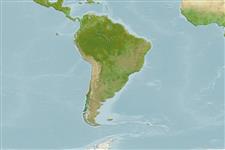Environment: milieu / climate zone / depth range / distribution range
Ecology
Marine; pelagic-neritic; depth range 0 - 70 m (Ref. 54915). Subtropical; 30°S - 37°S, 74°W - 70°W (Ref. 54915)
Southeast Pacific: Coquimbo, Valparaiso and south to Talcahuano, Chile; perhaps reaches further south to Mocha Island, but more southerly records may refer to Sprattus fuegensis. Subspecies have been noted (Ref. 6698): Strangomera bentincki bentincki (Talcahuano southward) and Strangomera bentincki cuga (Valparaiso to Talcahuano).
Length at first maturity / Size / Weight / Age
Maturity: Lm 10.5, range 10 - 11 cm
Max length : 28.4 cm SL male/unsexed; (Ref. 27363)
Occurs in schools at or near the surface in coastal waters. Feeds on plankton, especially diatoms (filter-feeding). Breeds mainly from June to November, from a length of about 10 cm. Eggs and larvae are planktonic (Ref. 52017). Mainly used for fishmeal.
Apparently releases planktonic eggs (similar to the demersal eggs of northern hemisphere Clupea).
Whitehead, P.J.P., 1985. FAO Species Catalogue. Vol. 7. Clupeoid fishes of the world (suborder Clupeoidei). An annotated and illustrated catalogue of the herrings, sardines, pilchards, sprats, shads, anchovies and wolf-herrings. FAO Fish. Synop. 125(7/1):1-303. Rome: FAO. (Ref. 188)
IUCN Red List Status (Ref. 130435)
Threat to humans
Harmless
Human uses
Fisheries: highly commercial
More information
ReferencesAquacultureAquaculture profileStrainsGeneticsElectrophoresesHeritabilityDiseasesProcessingNutrientsMass conversion
Tools
Special reports
Download XML
Internet sources
Estimates based on models
Phylogenetic diversity index (Ref.
82804): PD
50 = 1.0000 [Uniqueness, from 0.5 = low to 2.0 = high].
Bayesian length-weight: a=0.00603 (0.00346 - 0.01050), b=3.09 (2.93 - 3.25), in cm total length, based on LWR estimates for this species & (Sub)family-body (Ref.
93245).
Trophic level (Ref.
69278): 2.7 ±0.30 se; based on food items.
Resilience (Ref.
120179): High, minimum population doubling time less than 15 months (K=0.6).
Prior r = 1.11, 95% CL = 0.73 - 1.67, Based on 1 stock assessment.
Fishing Vulnerability (Ref.
59153): Low to moderate vulnerability (26 of 100).
Climate Vulnerability (Ref.
125649): Very high vulnerability (88 of 100).
Nutrients (Ref.
124155): Calcium = 134 [74, 232] mg/100g; Iron = 1.83 [1.01, 3.14] mg/100g; Protein = 19.4 [18.3, 20.5] %; Omega3 = 0.567 [0.348, 0.939] g/100g; Selenium = 23.8 [12.8, 46.2] μg/100g; VitaminA = 9.87 [3.19, 27.55] μg/100g; Zinc = 1.09 [0.75, 1.59] mg/100g (wet weight);
